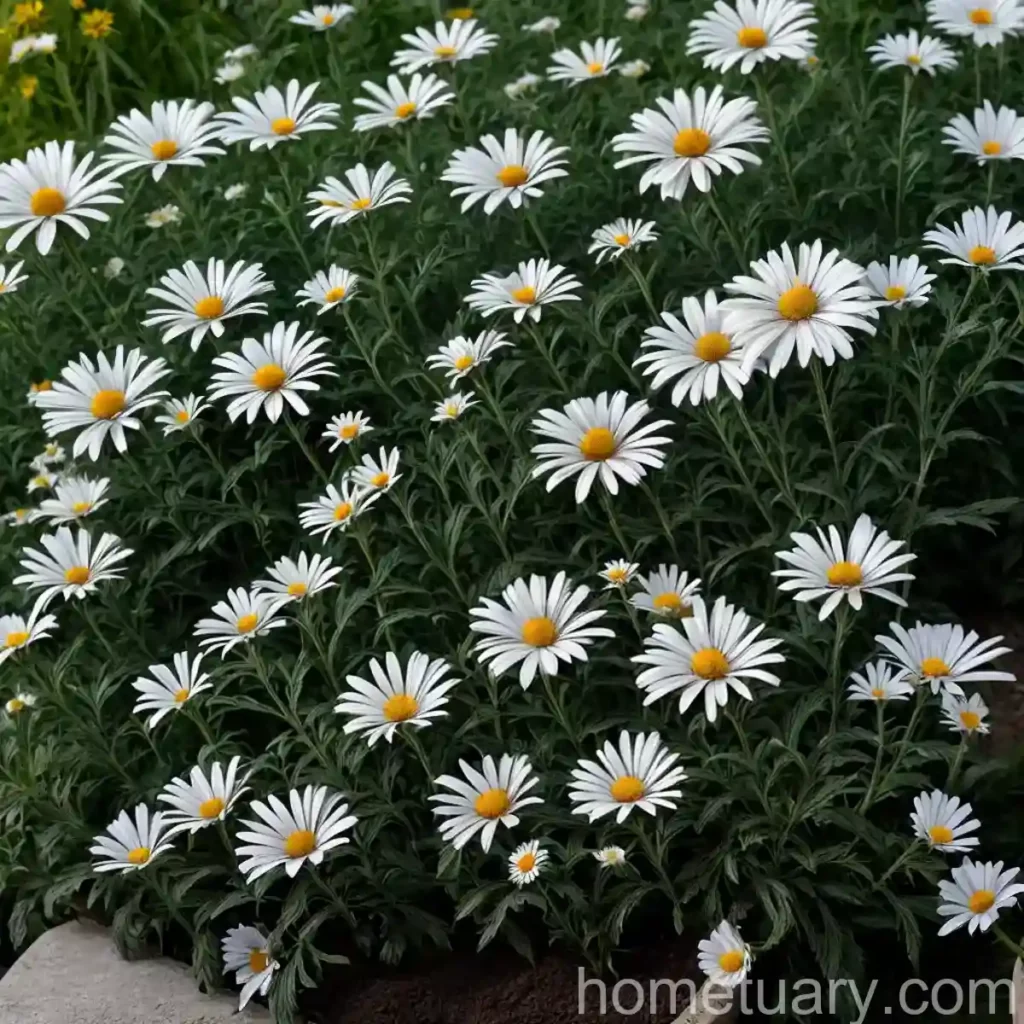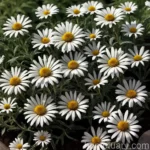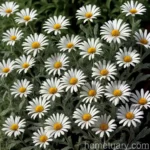All About Shasta Daisy (Leucanthemum x superbum ‘Becky’)
Shasta daisy (Leucanthemum x superbum ‘Becky’) is a delightful perennial plant that adorns gardens with its striking daisy-like flowers. Its appeal lies not only in its captivating beauty but also in its easy-care nature, making it a favorite among gardeners. In this comprehensive guide, we will explore the key characteristics of Shasta daisy, its culture, uses, care requirements, common diseases, and much more. Let’s dive in and unravel the wonders of this charming plant.
What is Shasta Daisy?
Shasta daisy, scientifically known as Leucanthemum x superbum ‘Becky’, is a herbaceous perennial that belongs to the Asteraceae family. This beautiful flowering plant is a hybrid of four wild daisy species native to Europe. The Leucanthemum genus includes a variety of daisy-like flowers, but the ‘Becky’ cultivar stands out for its exceptional vigor and abundant, large, white flowers with golden-yellow centers.
Key Takeaways – Shasta Daisy (Leucanthemum x superbum ‘Becky’)
- Shasta Daisy ‘Becky’: Known for its outstanding vigor and abundant, large, white flowers with golden-yellow centers.
- Leucanthemum x Superbum: A hybrid perennial originating from four wild daisy species native to Europe.
- Shasta Daisy Care: Requires well-drained soil, ample sunlight, and regular watering.
Culture
Shasta daisies are relatively easy to grow, making them suitable for both novice and experienced gardeners. Understanding the plant’s cultural requirements is essential to ensure its optimal growth and flowering.
Uses
Shasta daisies are versatile plants that find applications in various gardening scenarios and floral arrangements. They are commonly used for:
- Garden Borders: The striking white blooms of Shasta daisies make them perfect for edging garden borders, adding a touch of elegance to the landscape.
- Cut Flower Arrangements: The long, sturdy stems of Shasta daisies and their substantial blooms make them ideal for creating stunning cut flower arrangements.
- Wildlife Gardens: These daisies attract pollinators like butterflies and bees, enhancing the ecological diversity of the garden.
Water
Appropriate watering is crucial for the health and vitality of Shasta daisies. While they are relatively drought-tolerant once established, they benefit from regular watering, especially during dry spells. Here are some key points to consider regarding water requirements:
- Regular Watering: Keep the soil consistently moist but not waterlogged, particularly during the plant’s establishment phase.
- Deep Watering: Provide deep watering sessions rather than frequent shallow watering to encourage the development of a robust root system.
Sunlight
Shasta daisies thrive in full sunlight, rewarding gardeners with an abundance of beautiful blooms when provided with adequate light. Here’s what you need to know about sunlight requirements for Shasta daisies:
- Full Sun: Plant Shasta daisies in locations that receive at least 6-8 hours of direct sunlight per day for optimal growth and flowering.
- Partial Shade: While they prefer full sun, Shasta daisies can tolerate some light afternoon shade, particularly in regions with intense summer heat.
Fertilizer
Proper fertilization can significantly impact the growth and flowering capacity of Shasta daisies. Understanding the appropriate fertilizer application is essential for promoting healthy growth and prolific blooms.
- Balanced Fertilizer: Use a balanced, all-purpose fertilizer to provide essential nutrients for robust growth and prolific flowering.
- Spring Application: Apply a slow-release, balanced fertilizer in early spring to support vigorous growth and abundant blooming throughout the season.
Soil
The soil composition plays a vital role in the overall health and performance of Shasta daisies. Understanding the preferred soil conditions is crucial for cultivating thriving plants.
- Well-Drained Soil: Plant Shasta daisies in well-drained soil to prevent waterlogging, which can lead to root rot and other issues.
- Loamy Soil: They thrive in loamy soil with good fertility and a slightly acidic to neutral pH level (pH 6.5 – 7.5).
Pruning
Pruning is an essential aspect of Shasta daisy care, contributing to the plant’s overall health, appearance, and flowering prowess. Here are some key considerations for effective pruning:
- Deadheading: Regularly deadhead spent blooms to promote continuous flowering and prevent the plant from expending energy on seed production.
- Division: Every 2-3 years, consider dividing mature clumps in early spring to rejuvenate the plant and maintain its vigor.
Propagation
Shasta daisies can be propagated through various methods, allowing gardeners to expand their daisy collection or share these delightful plants with fellow enthusiasts. Here are some propagation techniques to consider:
- Division: Divide mature clumps in early spring to create new plants, rejuvenate existing ones, and maintain their vigor.
- Seeds: Collect and sow seeds for new plant generation, allowing for genetic diversity and the potential development of new cultivars.
Container Popularity
Shasta daisies are increasingly popular for container gardening, offering gardeners the opportunity to enjoy their radiant blooms in various settings, including patios, balconies, and urban gardens.
- Decorative Containers: Plant Shasta daisies in decorative containers to elevate outdoor spaces with their charming blooms.
- Versatile Placement: Containers allow for versatile placement of Shasta daisies, enabling enthusiasts to bring their beauty to diverse settings.
Common Diseases
Despite their resilience, Shasta daisies may encounter certain diseases that can affect their growth and vitality. Being aware of these common diseases is essential for early diagnosis and effective management.
- Powdery Mildew: Keep an eye out for powdery mildew, a common fungal disease that can affect Shasta daisies, particularly in humid conditions.
- Cercospora Leaf Spot: This fungal disease can manifest as circular spots on the foliage, potentially leading to leaf yellowing and drop.
- Botrytis Blight: Botrytis cinerea, or gray mold, can affect Shasta daisies, causing flower blight and other issues, especially in damp conditions.
Disease Diagnosis
When diagnosing potential diseases affecting Shasta daisies, careful observation and timely intervention play a critical role in preserving plant health and averting widespread issues.
- Visual Inspection: Regularly inspect the foliage, stems, and blooms for any signs of discoloration, spots, or unusual growth patterns.
- Consulting Experts: Seek guidance from experienced horticulturists or plant pathologists to accurately diagnose and address any potential disease concerns.
Common Pests
While Shasta daisies are relatively resistant to pest infestations, they may still encounter certain nuisances that can impact their overall well-being. Understanding the common pests of Shasta daisies is important for proactive pest management.
- Aphids: Keep an eye out for aphids, particularly on the new growth, undersides of leaves, and tender stems.
- Thrips: These tiny insects can affect the foliage and blooms, causing discoloration and deformation in severe cases.
- Slugs and Snails: These mollusks can cause damage to the foliage and blooms, particularly in damp or shaded areas.
Botanist’s Tips
As botanists, we are dedicated to promoting the health and prosperity of plants. Here are some expert tips for cultivating thriving Shasta daisies:
- Mulching: Apply a layer of organic mulch around Shasta daisies to retain moisture, suppress weeds, and provide insulation.
- Supportive Structures: Consider providing support, such as discreet stakes or rings, for tall Shasta daisy varieties to prevent flopping and support their magnificent blooms.
Fun Facts
Shasta daisies have a rich history and captivating characteristics that make them a beloved addition to gardens worldwide. Here are some fun and intriguing facts about these delightful plants:
- Historical Significance: Shasta daisies were first introduced by horticulturist Luther Burbank in the late 19th century, captivating gardening enthusiasts with their enchanting blooms.
- Symbolism: In the language of flowers, Shasta daisies symbolize purity, innocence, and new beginnings, making them popular choices for bouquets and floral arrangements.
- Drought Tolerance: While not entirely drought-resistant, Shasta daisies exhibit a degree of drought tolerance, making them suitable for landscapes with sporadic water availability.
Links to External Resources
- Royal Horticultural Society – Leucanthemum x superbum ‘Becky’
- University of Missouri Extension – Shasta Daisy
In conclusion, Shasta daisy (Leucanthemum x superbum ‘Becky’) is a remarkable perennial plant that brings joy to gardens with its radiant blooms and unfussy nature. By understanding its culture, care requirements, and potential challenges, gardeners can cultivate thriving Shasta daisies and revel in their enduring charm season after season. Whether adorning garden borders, gracing floral arrangements, or attracting beneficial wildlife, these daisies hold a special place in the hearts of plant enthusiasts and nature lovers alike. As we continue to appreciate and celebrate the beauty of Shasta daisies, may their elegance and resilience inspire a deeper reverence for the wonders of the natural world.















